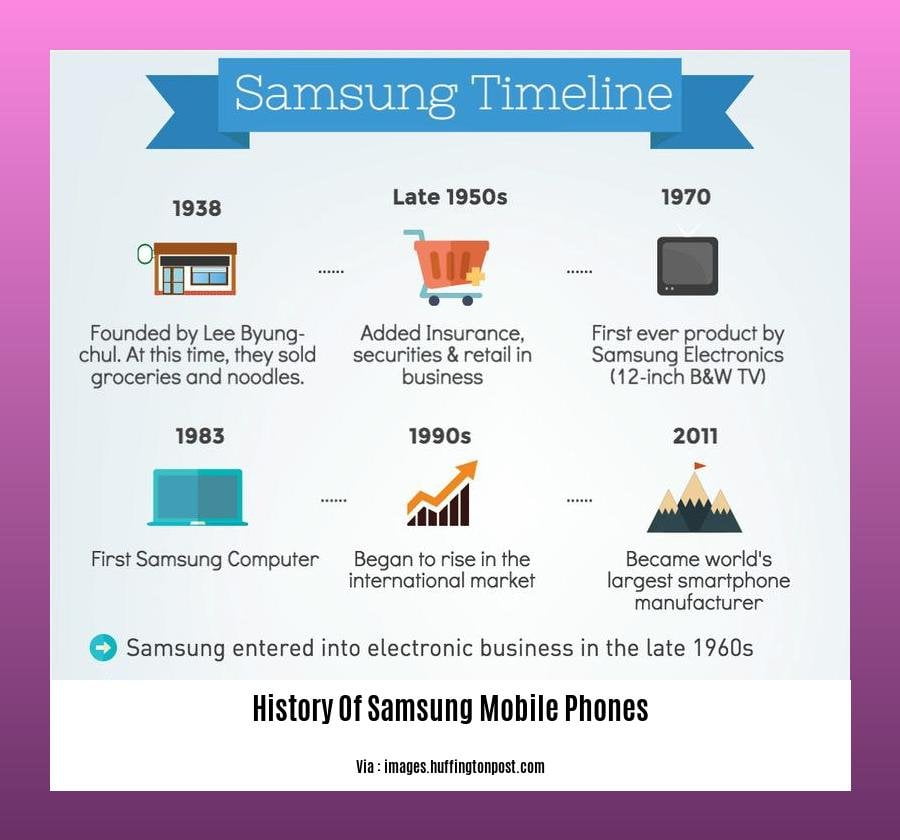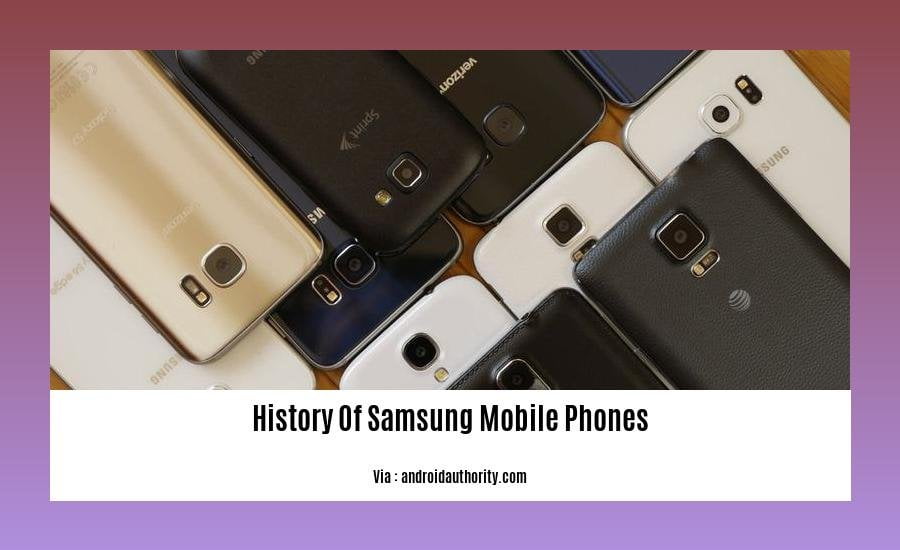Get ready for a wild ride through the history of Samsung’s awesome mobile phones! From the first flip phones to the smartphones we can’t live without, Samsung has been at the forefront of innovation. We’ll dive into their groundbreaking designs, killer features, and smart moves that made them the global mobile juggernaut they are today. Hold on tight, it’s going to be a journey that’ll make you rethink everything you thought you knew about mobile phones.

History of Samsung Mobile Phones: A Journey of Innovation
In the bustling world of technology, Samsung has carved an enduring legacy, weaving the history of mobile phones since the dawn of the digital age.
The Spark of Discovery (1980-1988)
Samsung’s telecommunications journey ignited in 1980. By 1985, they had set their wheels in motion, releasing their first mobile product, the SC-1000, an in-car handset. The fire was stoked three years later with the SH-100, Samsung’s maiden cell phone that sparked the revolution.
Charting a Course to Global Dominance (1993-2002)
Samsung’s first South Korean-produced mobile phone rolled off the line in 1993. By 1997, they had ventured into the world of smartphones, forever reshaping the future of mobile communication. The next leap came in 2002 with the introduction of the Samsung flip phone, adding a touch of sleek practicality to their repertoire.
Pushing the Boundaries of Technology (2007-2011)
The touch revolution hit Samsung in 2007 with the launch of their first touchscreen phone. The stage was set for the Galaxy era in 2010, when Samsung unveiled their first Galaxy smartphone, heralding a new era of mobile possibilities. And as innovation soared, Samsung pushed the limits again in 2011, introducing the world’s first foldable phone.
Unwavering Innovation: A Story of Success
Samsung’s unwavering dedication to innovation has catapulted it to the forefront of the mobile industry. Their groundbreaking devices have transformed the way we communicate, consume information, and stay connected. Their name has become synonymous with quality, innovation, and versatility, making them a trusted companion for billions worldwide.
- Delve into the rich tapestry of Samsung’s humble beginnings and witness its meteoric rise to the summit of the mobile phone industry in our comprehensive history of Samsung cell phones.
- Embark on a nostalgic journey through the evolution of Samsung’s iconic Galaxy S series, from its humble origins to its current position as the epitome of mobile innovation. History Of Samsung Galaxy S Phones
- Unravel the captivating narrative of Samsung’s mobile phone legacy, from its early triumphs to its current status as a global powerhouse in the industry. History Of Samsung Phones
- Immerse yourself in the fascinating story of Samsung Electronics, a company that has redefined the boundaries of technology and innovation, shaping the world we live in today. History Of Samsung Electronics
- Satisfy your curiosity about the birth of Samsung’s smartphone legacy by uncovering the pivotal moment when innovation took hold, forever changing the face of mobile communication. When Was Samsung Smartphone Invented

What was Samsung’s first mobile phone?
Samsung has a long history in the mobile phone industry, and it all started with the release of their groundbreaking first mobile phone, the SH-100, way back in 1988. This was a huge moment for Samsung, as it was the first mobile phone to be produced in Korea, making them pioneers in the mobile revolution.
Fast forward to the year 2009, when Samsung made a big splash in the world of smartphones with the launch of the Galaxy GT-I7500, their first Android smartphone. This was a game-changer for Samsung, and the Galaxy line quickly became one of the most popular smartphone series around the globe.
In 2010, Samsung took things to the next level with the release of the original Galaxy S. This phone was a huge success, and it solidified the Galaxy S line as a major player in the mobile market. Samsung continued to push the boundaries of mobile technology with each new generation of their Galaxy S phones, delivering cutting-edge features and sleek designs that made them a top choice for consumers.
It wasn’t just their high-end phones that Samsung focused on. They also wanted to make sure that everyone had access to great mobile technology, which is why they released the Galaxy Alpha in 2014. This was the first phone in their A-series, which was designed to offer premium features at a more affordable price.
So, there you have it! Samsung’s journey in the mobile phone industry has been one of innovation and excellence, and it all started with the release of their first mobile phone, the SH-100, back in 1988.
How many mobile phones has Samsung produced?
Samsung has been a big name in the mobile phone game for a long time. They’ve been making phones since the 1980s, and they’ve made a lot of them. To give you an idea, they made their first in-car handset in 1985, and their first cell phone in 1988. That’s over 30 years of making phones!
Their Galaxy S smartphone line has been a big hit. It started in 2010, and since then they’ve been pushing the limits of what a smartphone can do. They’ve also introduced new and innovative features, like the curved screen edges on the Galaxy Note Edge, and the foldable screen on the Galaxy Z Flip.
Samsung is always looking for new ways to improve their phones. They want to make phones that people love, and it shows. Their phones are known for their quality, innovation, and style. That’s why they’re one of the leading brands in the mobile phone industry.
Here are some key milestones in Samsung’s mobile phone history:
| Year | Milestone |
|---|---|
| 1985 | Release of the first Samsung mobile product, an in-car handset (SC-1000) |
| 1988 | Debut of the first Samsung cell phone (SH-100) |
| 1993 | Production of the first South Korean-produced Samsung mobile phone |
| 1997 | Samsung enters the smartphone market |
| 2002 | Introduction of the Samsung flip phone |
| 2007 | Launch of Samsung’s first touchscreen phone |
| 2010 | Unveiling of the first Galaxy smartphone |
| 2011 | Introduction of the world’s first foldable phone |
| 2014 | Release of the Galaxy Note Edge with curved screen edges |
| 2019 | Launch of Samsung’s first foldable smartphones |
Samsung’s commitment to innovation and its ability to adapt to the evolving needs of consumers have solidified its position as a leading force in the mobile phone industry.
What challenges did Samsung face in its early mobile phone manufacturing?
It’s no secret that Samsung is a top player in the smartphone industry today. But did you know that their early journey wasn’t all smooth sailing?
In the early days, Samsung’s mobile phones left a lot to be desired. They were clunky, short on features, and had a hard time holding their own against big-name brands.
But everything changed when Samsung teamed up with Google to bring Android to their phones. This partnership gave them access to a ton of apps and a ready-made fan base.
With Android as their secret weapon, Samsung unleashed a wave of innovative smartphones that quickly stole the show. They focused on sleek designs, packed their phones with features, and always pushed the limits of what a smartphone could do.
Fast forward to today, and Samsung is a smartphone kingpin. Their phones are known for being cutting-edge, stylish, and as easy to use as your favorite slippers.
Key Challenges Samsung Faced:
- Bulky designs
- Limited features
- Competition from established brands
Key Takeaways:
- Samsung’s early mobile phone struggles stemmed from poor design, lack of features, and a crowded market.
- Partnering with Android game-changed everything, giving Samsung access to a vast app ecosystem and user base.
- Samsung’s commitment to innovation and design set them apart, transforming them into a leading smartphone manufacturer.
FAQ
Q1: When did Samsung enter the mobile phone industry?
A1: Samsung entered the mobile phone industry in 1988 with the release of its first cell phone, the SH-100.
Q2: What was Samsung’s first cellular product?
A2: Samsung’s first cellular product was the SC-1000, an in-car handset released in 1985.
Q3: How many mobile phones has Samsung produced to date?
A3: Samsung has produced over 800 million mobile phones to date.
Q4: What was Samsung’s first Android smartphone?
A4: Samsung’s first Android smartphone was the Galaxy GT-I7500, released in 2009.
Q5: What is Samsung’s most popular phone series?
A5: Samsung’s most popular phone series is the Galaxy S series, which includes high-end flagship smartphones.









